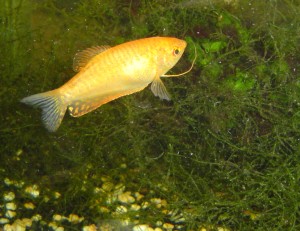Gorgeous Gourami
Trichogaster trichopterus Stunning Tropical Fish
The gourami comes in many sizes, shapes and a myriad of colors.
They also are quite an interesting fish with an amazing physical ability to breathe air from above the water's surface.
Just before we get to that let's look at one of these amazing fish in my tank...

This fish is a popular aquarium fish all around the world.
They are found mainly in Asia but one of the most interesting things about them, besides their color, is that they are a "Labyrinth" fish.
This means that they breathe air from above the water's surface.
This is possible because they have an auxiliary breathing apparatus which allows them to take a mouthful of air.
Isn't life and evolution wonderful? I mean, the diversity that you see in the fish world is absolutely remarkable and stimulating!
When they swim back down again to the bottom of the aquarium the air is forced into a special area known as the labyrinth which is in the fish's head.
From there the air is passed into the blood stream.
They can, however, still extract dissolved oxygen from the water but the labyrinth allows them to live in oxygen-poor aquarium water longer than other fish.
It is the color of these fish though that interests most hobbyists and aquarium keepers. And the colors are both stunning and widely varied!
Here's just a short list of some types of these wonderful fish...
These fish, if kept in the right aquarium conditions, will grow to a length of about 2 1/2 to 6 inches or about 5 to 15 centimeters.
The "right conditions" can vary amongst these fish. For instance the Chocolate needs more carefully controlled water conditions than the others and is highly prone to diseases, fungus, parasites and the like.
It is also highly unlikely to eat flake food.
On the other hand the Gold is much hardier. It lasts much longer in the community tank but sometimes it will bully other smaller fish.
It is less prone to disease than the Chocolate and will tolerate more difficult conditions.
Overall they are a good tropical fish to include in your community aquarium.
They will easily thrive alongside Barbs, Bala Sharks, Clown Loaches, Tetras, Catfish and most other types of gourami.
More Info on the Gourami...
And to learn a bit more about the gourami click here...